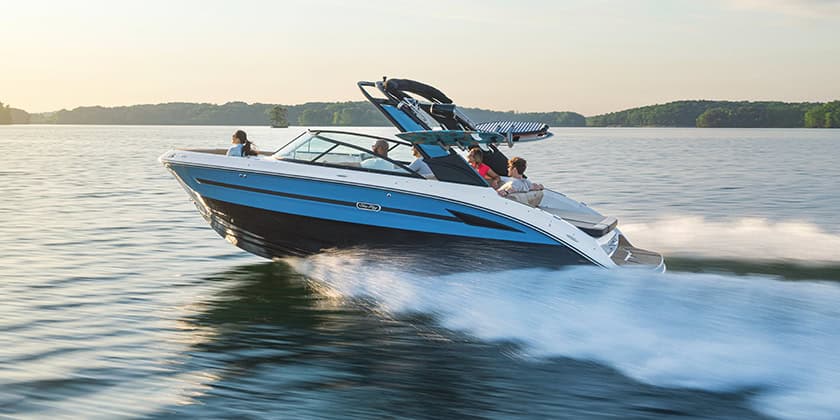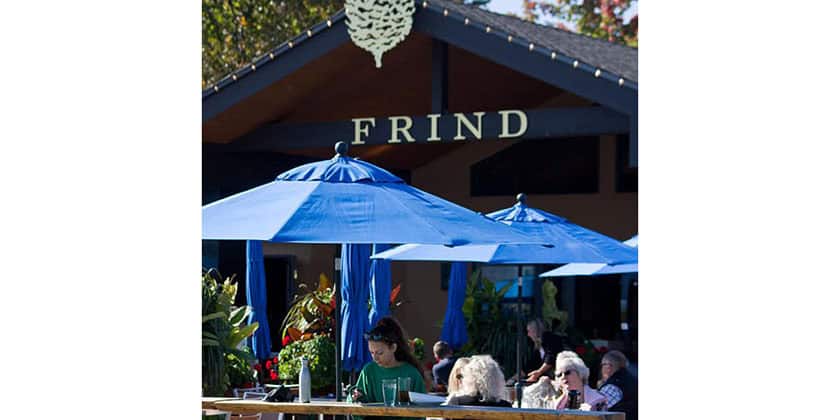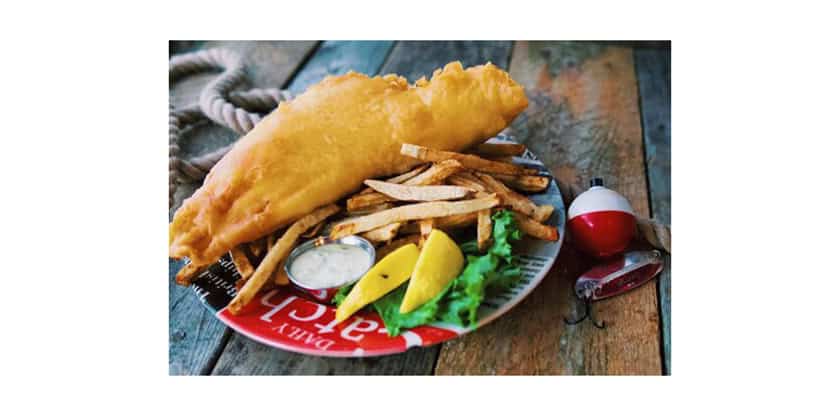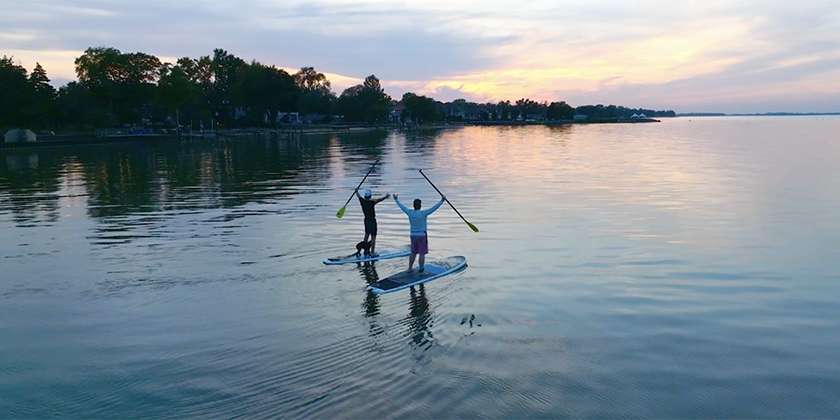The Saga 35
By Heather Ormerod
The Annapolis Boat Show is a popular Thanksgiving destination for Canadian sailors. For many of us, it is our last chance to eat, breathe and sleep sailing until spring, but it is also one of the best places to inspect the newest and hottest boats on the market. For the last three years, one of the boats that have garnered a significant amount of attention and praise is the Saga 43. This vessel is the flagship boat for Saga Marine, which was formed in 1995. With its distinctive styling, superb performance and sturdy offshore credentials, this cruiser created quite a buzz at the 1996 Annapolis show. Many show-goers actively sought out this new boat in hopes of seeing for themselves what all of the fuss was about and learning more about this new boat-building company. Many Canadians, who had just made the long trek south for the weekend, were among the curious. Imagine their surprise when they discovered that this hot new boat was actually built right in their own backyard.
Saga Marine, which is based in St. Catharines, Ontario and is comprised of a handful of past C&C Yachts and Hinterhoeller Yachts employees, not the least of which is Allan Poole, a former president of Hinterhoeller, continues to be one of Canada’s best-kept boat-building secrets.
But with the recent addition of the Saga 35, to its product line, this home-grown company is undoubtedly going to be attracting a lot more attention this side of the border.
 The need for speed
The need for speed
The Saga 35 was designed by Bob Perry, who is well-known for another performance cruiser – the Valiant 40 – but there is no mistaking the Saga 35 for a Valiant. An extremely beefy looking bowsprit that supports the furling genoa and anchor rollers extends well beyond the plumb bow. Looking at the hull head-on, reveals that the bow flares as it comes up to meet the deck. The hull is slender by modern standards, with the beam carried over the length of the 34-foot waterline, but aft of the midships there is little reduction in the beam, which provides for a roomy cockpit.
Although the design percentages are slightly different, the Saga 35 runs with many of the Saga 43’s winning concepts – it is a low maintenance cruiser that is built for people who want a boat that sails well and fast. “Speed is important,” says Poole. “We wanted to build a boat that focused on the pleasure of sailing, the ease of sailing, but could also get you where you are going fast.” If you are looking to make comparisons with other boats on the market, the depth of craftsmanship and quality puts this boat in direct competition with Tartan, Pacific or Seacraft. Performance wise, it is similar to a CS 36 in the fact that it is comfortable and fast, but there is more space in the cockpit and aft cabin, and sufficient buoyancy to carry much more weight.
On deck
The Saga 35 may be built for speed, but it is cruiser through and through. There is ample storage in the cockpit. To port of the helm is a propane locker that will hold two 20-pound tanks, as opposed to the usual 10-pound provisioning. The cockpit lazarette is about five and a half feet deep, affording massive amounts of storage, and there are steps to get in and out. To starboard, there is a vented locker for carrying a gasoline can.
 The wheel isn’t very big for a boat of this size, but it is a tight squeeze past wheel as it is, and the Whitlock steering gives the wheel a tiller-like responsiveness, so size shouldn’t be a problem. A narrow seat panel flips up behind the helm, to provide for a walk-through transom.
The wheel isn’t very big for a boat of this size, but it is a tight squeeze past wheel as it is, and the Whitlock steering gives the wheel a tiller-like responsiveness, so size shouldn’t be a problem. A narrow seat panel flips up behind the helm, to provide for a walk-through transom.
The deck layout is definitely for those who would rather be out sailing than stuck at the dock. There is no teak or wood used on the exterior and the two tone, diamond-patterned non skid is not only comfortable, but also easy to clean. Stainless steel grab rails run the length of the coach house, another low maintenance bonus, but also an important safety feature. As are the 28-inch lifelines (24-inch is standard) and safety harness padeyes in the cockpit. There are six opening ports and two fixed ports, all of which are stainless steel, and four overhead hatches. Harken gear is used throughout the deck. The genoa/jib winches are located back beside the cockpit, and there are two more winches on the coach house roof, alongside banks of Spinlock stoppers. Rope lockers, located in the cockpit coaming below the genoa winches, help keep things tidy in the cockpit.
Down below
Below decks, this boat is nothing like its hoseit-off-and-go exterior. The interior is soft and cozy. Ample use of cherry wood and soft fabrics give the cabin a luxurious feel. Both settees have slightly backward -angled back rests that make sitting and relaxing down below lovely. The chainplates are hidden behind cherry panels and ash strips line the hull interior. The mast is located forward of the bulkhead, which does wonders to open up the cabin. Halogen lights provide gentle, natural lighting after dark.
The navigation table is situated at the end of the starboard settee. It is a good sized charttable, but it is the electrical panel beside it that really impresses. Behind the fold-down panel the wiring is immaculate, and each wire is numbered to correspond with a maintenance reference sheet that identifies it and describes its function.
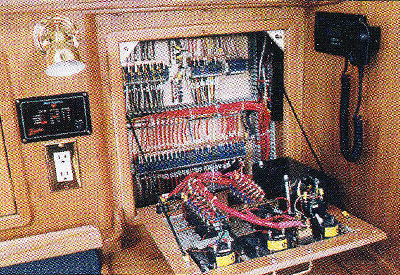 The galley is U-shaped with three burner stove in centre. There is good counter area, an ice box with an optional freezer/refrigerator, and plenty of shelves and drawers for storage. The freezer lid has a lip that wraps down into the front of the cabinet face below, so that when you want to get something out of the fridge, you don’t have the hang over a high counter edge to reach the very bottom. Hot and cold pressure water is standard, but there is a foot pump, should you need it. The galley comes complete with a chef’s belt for offshore cooks.
The galley is U-shaped with three burner stove in centre. There is good counter area, an ice box with an optional freezer/refrigerator, and plenty of shelves and drawers for storage. The freezer lid has a lip that wraps down into the front of the cabinet face below, so that when you want to get something out of the fridge, you don’t have the hang over a high counter edge to reach the very bottom. Hot and cold pressure water is standard, but there is a foot pump, should you need it. The galley comes complete with a chef’s belt for offshore cooks.
The aft cabin is the smaller of the two sleeping quarters. Located on the starboard side of the boat, this cabin offers great standing headroom in the area immediately in front of the bunk and two hanging lockers side by side; both are cedar-lined. The bunk itself is large and comfortable, but it is primarily tucked under the cockpit sole, so it isn’t terribly bright, although Saga reports that this will be remedied with the addition of a port in the cockpit side of subsequent boats. Despite the fact that the V-berth shares the front end of the boat with the head, it is roomy. The 52- inch-wide bunk is 6’4″ at its shortest point and 7’6″ at its longest point.
Deep, long shelves run along the hull and there is a large cedar-lined hanging locker. A small cushioned bench, tucked in beside the bunk and slightly lower, is stylish and a good seat for those getting dressed. The head can be accessed through the salon or the V berth, which helps maintain some privacy when there are guests on board. There is the standard sink, shower and toilet, as well as a large mirror installed at eye-level and a roomy cupboard for storage. Overall, the level of finish down below is fantastic. The woodwork is flawless and there is a number of small touches, such as brass accents, attractive trim and covered screw heads – even the door for the valves in the head is finished beautifully – that bespeak a high level of craftsmanship.
Under way
Our test boat was equipped with an optional folding prop and a naturally aspirated, 38-horsepower Yanmar diesel. This engine has a lot of gusto. With 60 gallons of fuel the Saga 35 will motor at seven knots for more than 400 miles. It also has an electric oil-change pump and can be removed from the boat without any structural alterations.
The unique Variable Geometry RigTM of the Saga 35 mean s that your full sail inventory is only a furling line away. The genoa and jib are each set on their own roller-furling stay – both furling units are standard equipment – but unlike a cutter rig, the two headsails are not meant to be set at the same time. The self-tacking jib is for upwind sailing and heavy winds, and the larger genoa is for off-wind angles. With the self-tacking jib, you can tack upwind without touching the sheets. This is a huge advantage for sailing couples and ideal for single-handers. As is the simple furling and the single-line reefing that is led back to the cockpit. The luff-track system from Tides Marine that shuttles the main up and down the mast is incredibly smooth; once released, the heavily roached main sail drops in less than two seconds. Hood built all sails on our test boat.
The wind was less than favourable – almost nonexistent, in fact – for our test sail. But we were all eager to see this brand new boat out on the lake (hull number one, test sail number one), so we headed out regardless. From what little wind we did have, it was clear that the boat is extremely well balanced. The long, narrow hull gives the boat its great tracking ability and makes it a rocket on water. In the small puffs the boat accelerated noticeably and quickly. With the 130 percent genoa fastened to the tip of the bowsprit, it is more like having a 140 percent sail up front. Tests under power and sail revealed that the boat had a tight turning radius and a responsive helm.
According to the Saga Marine crew, since our test sail the boat sailed the 26 miles from St. Catherines to Port Credit, Ontario in three and a half hours. While sailing from New port, Rhode Island to Norwalk, Connecticut, the boat balanced so well that it steered itself for three hours-no autopilot required.
While the Saga 35 is completely set up for off shore cruising, Poole hopes that the concepts that made the Saga 43 so successful, will have greater appeal to lake sailors, now that they are in a smaller package. With one Saga 35 completed and two more on order, things appear to be going as planned.
Originally published in Canadian Yachting’s fall 1999 issue.
Specifications
L.O.A 35′ 6″
L.W.L 33′ 7″
Beam 10′ 3″
Draft -deep 6′ 6″
-shoal 4′ 11″
Displacement 13,700 lb.
Sail Area 696 sq. ft.
SAGA Marine
423 Lakeshore Road
St. Catharines, Ont. L2R 7K6 1-800-560-SAGA










